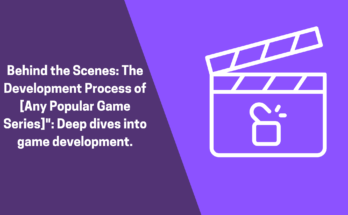Introduction
Video games have become one of the most popular forms of entertainment, with millions of players worldwide enjoying immersive experiences across various genres. However, few people realize the enormous effort, creativity, and technical expertise required to bring a game to life. In this article, we will take a behind-the-scenes look at the intricate process of game development, from initial concept to final release.
Concept and Pre-Production
1. Idea Generation
Every great game starts with an idea. Developers brainstorm unique concepts, storylines, and gameplay mechanics that will define the game. Inspiration can come from books, movies, real-life experiences, or completely original visions.
2. Market Research and Feasibility
Once a concept is established, developers conduct market research to determine its potential success. They analyze competitors, assess player interest, and determine technical feasibility.
3. Game Design Document (GDD)
A GDD serves as the blueprint for the entire development process. It outlines the core gameplay mechanics, storyline, character designs, level structures, and technical specifications.
4. Prototyping
Before full-scale development begins, small prototypes are created to test fundamental mechanics. These prototypes help developers refine gameplay elements, identify potential issues, and determine if the concept is viable.

Production Phase
5. Art and Design
Artists and designers create the visual elements of the game, including character models, environments, animations, and UI/UX design. Modern game engines like Unity and Unreal Engine allow developers to create stunning 3D and 2D visuals.
6. Programming and Development
Programmers write the game’s code, implementing mechanics, AI behavior, and physics. Development involves using programming languages like C++, C#, or Python, depending on the platform and engine used.
7. Sound and Music
Audio designers and composers craft the game’s sound effects and soundtrack. Music plays a crucial role in setting the game’s tone and enhancing immersion.
8. Level Design
Level designers build the game world, ensuring a balance between challenge and enjoyment. They create maps, place interactive objects, and optimize layouts for an engaging experience.
Testing and Quality Assurance
9. Alpha Testing
The game enters the alpha stage when basic mechanics and features are implemented. Internal teams and select players test the game to identify major bugs and gameplay inconsistencies.
10. Beta Testing
A more refined version of the game is released to a limited audience for beta testing. This phase allows developers to gather player feedback, identify remaining issues, and make necessary adjustments.
11. Bug Fixing and Optimization
Developers fix reported bugs, optimize performance, and ensure smooth gameplay across all platforms. Optimization is crucial for delivering a polished final product.
Launch and Post-Release Support
12. Marketing and Promotion
Marketing teams create trailers, social media campaigns, and pre-release hype to attract players. Game expos, influencer collaborations, and press coverage play a vital role in generating interest.
13. Game Launch
The game is officially released on various platforms, including PC, consoles, and mobile devices. Developers monitor player feedback and quickly address any critical issues.
14. Post-launch updates and DLC
To maintain player engagement, developers release updates, bug fixes, and downloadable content (DLC). Live-service games continuously evolve with seasonal content and expansions.
Conclusion
Creating a video game is a complex process that requires collaboration, creativity, and technical expertise. From concept to release, countless hours go into crafting the experiences that players love. The next time you play your favorite game, take a moment to appreciate the incredible effort behind the scenes that brought it to life.
Read our other blog on A Deep Dive into Hyper-Casual Games: What Makes Them So Addictive?

